Scientific Session
Other Nuclei MRI and MRS to Study Metabolism
| Tuesday Parallel 5 Live Q&A | Tuesday, 11 August 2020, 13:45 - 14:30 UTC | Moderators: Joshua Kaggie |
 |
0487.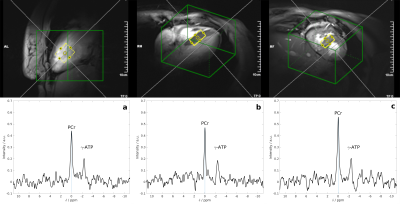 |
Cardiac 31P MR Spectroscopy With Interleaved 1H Image Navigation for Prospective Respiratory Motion Compensation – Initial Results
Stefan Wampl1,2, Tito Körner1,2, Sigrun Roat1,2, Michael Wolzt3, Ewald Moser1,2, Siegfried Trattnig2,4, Martin Meyerspeer1,2, and Albrecht Ingo Schmid1,2
1Center for Medical Physics and Biomedical Engineering, Medical University of Vienna, Vienna, Austria, 2MR Center of Excellence, Medical University of Vienna, Vienna, Austria, 3Department of Clinical Pharmacology, Medical University of Vienna, Vienna, Austria, 4Department of Biomedical Imaging and Image-guided Therapy, Medical University of Vienna, Vienna, Austria Cardiac phosphorus (31P) magnetic resonance spectroscopy (MRS) offers unique insights into the metabolism of the human heart. To further improve cardiac 31P MRS acquisitions, the implementation of a proton (1H) magnetic resonance imaging (MRI) navigator into a 31P MRS pulse sequence using multinuclear interleaving is demonstrated. In this feasibility study we further apply a method to robustly detect the heart on low-resolution navigator images. Combined with multinuclear interleaving this facilitates time-efficient position updates of the 31P MRS voxel to prospectively correct for respiratory motion. |
0488.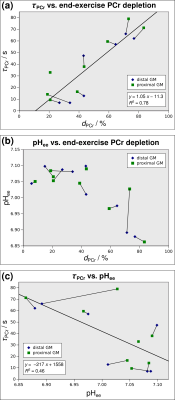 |
Studying Human Plantar Flexor Muscles at Low-Intensity Exercise by Interleaving Perfusion 1H MRI with Localised 31P MRS
Fabian Niess1,2, Albrecht Ingo Schmid1,2, Siegfried Trattnig2,3, Ewald Moser1,2, and Martin Meyerspeer1,2
1Center for Medical Physics and Biomedical Engineering, Medical University of Vienna, Wien, Austria, 2High-Field MR Centre, Medical University of Vienna, Wien, Austria, 3Department of Biomedical Imaging and Image-guided Therapy, Medical University of Vienna, Wien, Austria
The purpose of this study is to show the effect of low-intensity exercise on localised 31P MR spectra and 1H images of human muscle. It was determined which PCr depletion is sufficient for quantifying the PCr recovery time constant (τPCr), while incurring minimal pH drop in a predominantly glycolytic muscle. PCr depletion during exercise was measured, PCr recovery was fitted and pH was quantified with dynamic localised 31P MRS, while perfusion and BOLD 1H images were simultaneously acquired in time-resolved measurements. Prolongation of τPCr with acidification was confirmed, while very short τPCr was found with neutral and slightly acidic pH.
|
|
 |
0489.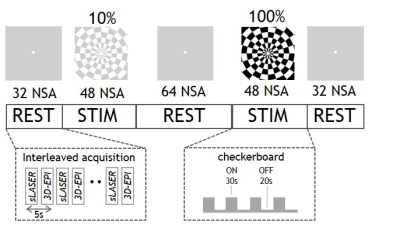 |
A 7T interleaved fMRS and fMRI study on visual contrast dependency in the human brain.
Anouk Schrantee1, Chloe Najac2, Chris Jungerius2, Aart J Nederveen1, Vincent O Boer3, Wietske van der Zwaag4, Silvia Mangia5, and Itamar Ronen2
1Department of Radiology and Nuclear Medicine, Amsterdam University Medical Center, University of Amsterdam, Amsterdam, Netherlands, 2C.J. Gorter Center for High Field MRI, Department of Radiology, Leiden University Medical Center, Leiden, Netherlands, 3Danish Research Centre for Magnetic Resonance, Centre for Functional and Diagnostic Imaging and Research, Copenhagen University Hospital Hvidovre, Hvidovre, Denmark, 4Spinoza Centre for Neuroimaging, Royal Netherlands Academy of Arts and Sciences, Amsterdam, Netherlands, 5Center for Magnetic Resonance Research, Department of Radiology, University of Minnesota, Minneapolis, MN, United States
Functional magnetic resonance spectroscopy can non-invasively measure changes in local concentrations of neurometabolites and has been used to demonstrate changes in lactate and glutamate levels in response to visual stimulation. However, whether the neurometabolite response scales with the level of neuronal stimulation like the BOLD response, has not been extensively investigated. We here show that lactate, but not glutamate levels, change dependent on visual contrast levels (baseline, 10%, 100% contrast). Although we also demonstrate a significant contrast dependence in the BOLD response, we do not find a significant association between the lactate response and the BOLD response.
|
 |
0490.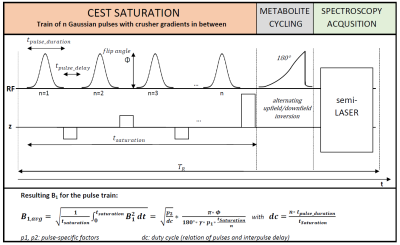 |
Combining CEST and 1H MR Spectroscopy for simultaneous determination of metabolite concentrations and effects of magnetization exchange
Maike Hoefemann1, André Döring1, and Roland Kreis1
1Departments of Radiology and Biomedical Research, University of Bern, Bern, Switzerland
A new sequence design was used to combine the CEST saturation method with traditional MRS. Using non-water suppressed metabolite-cycled spectroscopy offers the time-saving simultaneous recording of the traditional CEST z-spectrum and the metabolite spectrum under frequency selective saturation and allows the detection of exchange and magnetization transfer effects on metabolites and macromolecules. This technique might offer additional possibilities for quantifying the metabolite and macromolecular content or give further insight into the composition of the traditional CEST z-spectrum and is also relevant for judging the influence of water-suppression on absolute metabolite signals.
|
0491.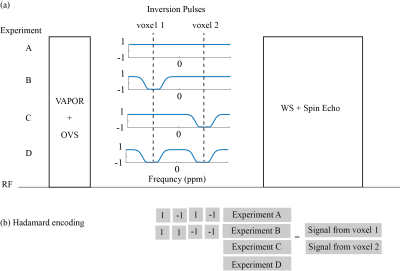 |
Simultaneous ultra-short TE-MRS in two voxels using a SPECIAL sequence with Hadamard encoding
Masoumeh Dehghani1,2, Richard Edden 3, and Jamie Near1,2
Video Permission Withheld
1McGill University, Montreal, QC, Canada, 2Centre d'Imagerie Cérébrale, Montreal, QC, Canada, 3Johns Hopkins University, Baltimore, MD, United States
The spin echo, full Intensity acquired localized (SPECIAL) sequence consists of a localized spin-echo, preceded by an alternating ISIS pre-inversion for voxel localization. In this study we modified the SPECIAL sequence to simultaneously localize the signal at two different positions. The technique relies on a four-step inversion scheme involving two different inversion positions, followed by a Hadamard encoding reconstruction. Comparing the in vivo performance of dual-SPECIAL sequence to the conventional SPECIAL sequence demonstrated that the dual-Special sequence provides simultaneous metabolite profile from two different regions, reducing the acquisition time by a factor of two, and without any penalty in SNR.
|
|
0492.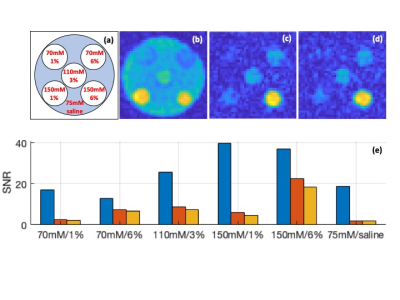 |
Simultaneous Acquisition of Spin-density-weighted and SNR-enhanced Fluid-attenuated 23Na MRI Images (SELA)
Chengchuan Wu1, Yasmin Blunck1, and Leigh Johnston1
1Biomedical Engineering, The University of Melbourne, Parkville, Australia
This work presents SELA, a 23Na MRI sequence that can simultaneously acquire spin-density-weighted (SDW) and SNR-enhanced fluid-attenuated (FLAIR) images in one scan. The sequence was examined by numerical simulation and phantom experiment in a 7T preclinical scanner. Preliminary results support the design purpose to improve 23Na MRI efficiency and 23Na-FLAIR image quality.
|
|
0493.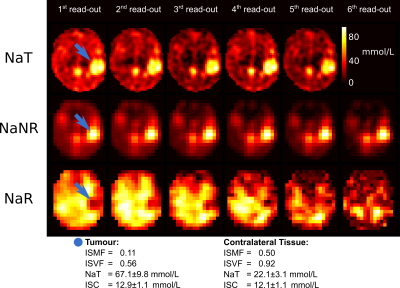 |
Quantitative Multiple Quantum Filtered Sodium MRI and [18F]-FET-PET: Complementary Imaging Techniques for the Study of Cerebral Gliomas
Wieland A Worthoff1, Aliaksandra Shymanskaya2, Karl-Josef Langen1,3,4, and N. Jon Shah1,2,4,5
1Institute of Neuroscience and Medicine - 4, Forschungszentrum Jülich GmbH, Jülich, Germany, 2Institute of Neuroscience and Medicine - 11, Forschungszentrum Jülich GmbH, Jülich, Germany, 3Department of Nuclear Medicine, RWTH Aachen University, Aachen, Germany, 4Section JARA-Brain, Jülich-Aachen Research Alliance, Aachen, Germany, 5Department of Neurology, RWTH Aachen University, Aachen, Germany
A cohort of patients with untreated cerebral gliomas underwent consecutive [18F]-FET-PET and sodium MRI exams. It is shown that quantitative results from multiple quantum filtered sodium MRI using the enhanced SISTINA sequence offer access to the metabolic properties of tumours beyond what is observed by [18F]-FET-PET alone, thus presenting the potential to serve as an additional marker in tumour diagnostics.
|
|
0494.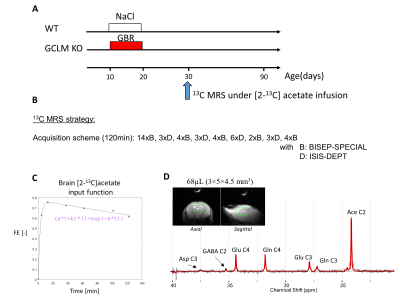 |
Cerebral energy metabolism and neurotransmission in a schizophrenia mouse model: a combined 1H-[13C] MRS and 13C MRS study at 14.1T
Bernard Lanz1, Radek Skupienski2,3,4, Kim Q Do2, and Lijing Xin3
1LIFMET, Ecole Polytechnique Fédérale de Lausanne, Lausanne, Switzerland, 2Center for Psychiatric Neuroscience, Department of Psychiatry, Lausanne University Hospital (CHUV), Prilly, Switzerland, 3Center for Biomedical Imaging (CIBM), Ecole Polytechnique Fédérale de Lausanne, Lausanne, Switzerland, 4HES-SO, University of Applied Sciences of Western Switzerland, HEIA-FR, Institute of Chemical Technology, Fribourg, Switzerland
In this study, we applied interleaved localized 1H-[13C]-MRS and direct 13C MRS with polarization transfer to characterize brain energy metabolism in the early development of a GCLM-KO mouse model with infusion of [2-13C]acetate. This strategy enabled to measure simultaneously the [2-13C]acetate input function, glutamate and glutamine C4 and C3 enrichment and pool size changes. Two-compartment metabolic modelling was then applied to characterize mitochondrial metabolism and glutamate/glutamine cycling and compare it to a control group.
|
|
 |
0495.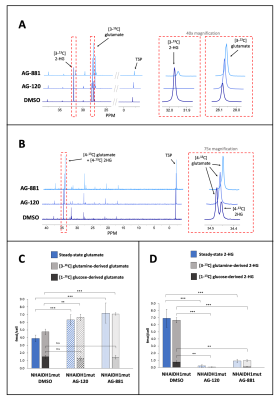 |
Metabolic reprogramming associated with IDH1-targeted treatments in low-grade glioma cell models: a 1H and 13C MRS study
Abigail R Molloy1, Chloé Najac1, Aliya Lakhani1, Elavarasan Subramani1, Georgios Batsios1, Anne Marie Gillespie1, Russell O Pieper2,3, Pavithra Viswanath1, and Sabrina M Ronen1,3
1Radiology and Biomedical Imaging, University of California, San Francisco, San Francisco, CA, United States, 2Department of Neurological Surgery, University of California, San Francisco, San Francisco, CA, United States, 3Brain Tumor Research Center, University of California, San Francisco, San Francisco, CA, United States
Mutant IDH1 (IDH1mut) drives glioma development, and targeted IDH1mut inhibitors show promising results in clinical trials. However, treatment is not associated with tumor shrinkage, and there is an urgent need for early imaging biomarkers of response. Our studies in IDH1mut-expressing glioma cells indicate that treatment with IDH1mut inhibitors leads to 1H and 13C-MRS-detectable metabolic changes. Specifically, we show a decrease in 2-HG and increase in glutamate, as well as an increase in metabolic flux from glutamine to glutamate. Furthermore, hyperpolarized [1-13C] α-ketoglutarate can probe these alterations in metabolism. This identifies potential non-invasive biomarkers of response to IDH1mut inhibition in glioma.
|
0496.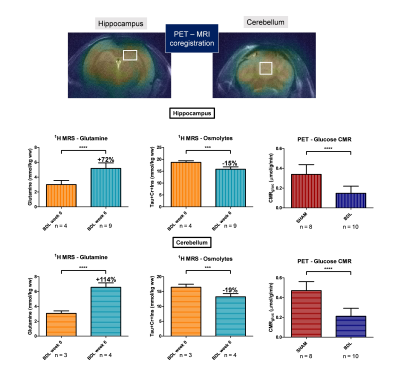 |
Multimodal assessment of brain energy metabolism in a rat model of hepatic encephalopathy using 1H-MRS and 18F-FDG PET – a pilot study
Jessie Mosso1,2, Carole Poitry-Yamate1, Dunja Simicic1,2, Mario Lepore1, Cristina Cudalbu1, and Bernard Lanz2
1Center for biomedical imaging (CIBM), EPFL, Lausanne, Switzerland, 2Laboratory for functional and metabolic imaging (LIFMET), EPFL, Lausanne, Switzerland
Hepatic encephalopathy (HE) is a severe complication of chronic liver disease which drastically affects patient lives. Its underlying mechanisms are still unknown and energy metabolism studies are of key interest. Here, we combined 18F-FDG PET and 1H-MRS and found a 2-fold decrease in brain glucose uptake in a rat model of HE compared to SHAM rats, associated with a previously reported increase in brain glutamine and decrease in osmolytes. Although the difference in glucose uptake measured by PET results from a combination of brain and systemic effects, this finding provides a new perspective on HE pathophysiology.
|

 Back to Program-at-a-Glance
Back to Program-at-a-Glance Watch the Video
Watch the Video Back to Top
Back to Top